Pioz 15mg Tablet 10’S
Original price was: ₹83.00.₹75.00Current price is: ₹75.00.
Introduction About PIOZ 15MG TABLET
What is Pioz 15mg Tablet?
Pioz 15mg Tablet contains Pioglitazone, a medication used for type 2 diabetes management. It helps control blood sugar levels by increasing insulin sensitivity.
Pioz 15mg Tablet can be taken alone or with other diabetes medication. It is important to take it consistently at the same time each day for the best results.
Take Pioz 15mg as prescribed by your doctor, usually once daily with or without food. Regular monitoring of blood sugar levels, as well as blood tests to check blood cell counts and liver function, may be advised by your doctor.
Pioz 15mg Tablet should be part of a comprehensive management plan, including a healthy diet, regular exercise, and weight management, as recommended by your doctor.
Before taking Pioz 15mg Tablet, inform your doctor if you have a history of heart disease, thyroid disorders, or hormonal conditions, as it may not be suitable.
The most common side effects of taking Pioz 15mg Tablet are weight gain or swelling in legs. Consult your doctor if you experience above side effects worsen or persists for a longer duration.
Key Composition
Active Ingredient:
- Pioglitazone hydrochloride (15mg) – A thiazolidinedione (TZD) class drug that helps improve insulin sensitivity in type 2 diabetes patients
Inactive ingredients (excipients):
- Lactose monohydrate
- Microcrystalline cellulose
- Povidone (Polyvinylpyrrolidone, PVP)
- Sodium starch glycolate
- Magnesium stearate
Uses Of PIOZ 15MG TABLET
- Type II diabetes mellitus
Benefits of PIOZ 15MG TABLET
1. Controls blood sugar in type 2 diabetes:
- Pioz 15mg helps lower blood glucose levels by enhancing the body response to insulin
- Ensures better sugar utilization and reduces glucose production in the liver
2. Reduces insulin resistance:
- Pioglitazone improves insulin sensitivity in muscle and fat tissues, making it easier for cells to absorb glucose from the bloodstream
- This reduces the need for higher insulin levels and helps in reducing metabolic complications
3. Helps to reduce diabetes complications:
- Long-term use can lower the risk of diabetes-related complications, including nerve damage (neuropathy), kidney problems (nephropathy), and vision issues (retinopathy)
- Pioz Tablet may also provide cardiovascular protection by improving lipid levels and reducing inflammation
How PIOZ 15MG TABLET Works
1. Reduces insulin resistance
- In type 2 diabetes, cells become resistant to insulin, meaning they do not efficiently absorb glucose
- Pioglitazone activates PPAR-γ (Peroxisome Proliferator-Activated Receptor Gamma), a protein that enhances insulin sensitivity in fat, muscle, and liver cells
- It reduces insulin resistance, allowing cells to better absorb glucose from the bloodstream
2. Enhances glucose utilization:
- Muscle and fat cells absorb more glucose, lowering blood sugar levels
- It reduces excess glucose production in the liver, reducing high fasting blood sugar levels
3. Protects against diabetes complications
- Reduces lipid abnormalities, improving heart health
- Lowers inflammation, which is beneficial for reducing complications like nerve damage, kidney disease, and vision issues
How long does it take for Pioz 15mg to show results?
- Initial effects: 1 to 2 weeks – some improvement in blood sugar levels may be observed
- Significant improvement: 4 to 8 weeks – insulin sensitivity improves, leading to better glucose control
- Full therapeutic effect: Up to 12 weeks – maximum benefits in reducing blood sugar levels and insulin resistance
How to use PIOZ 15MG TABLET
Pioz 15mg Tablet is a prescription medicine which needs to be taken under medical supervision. Always consult your doctor or pharmacist if you have any questions or concerns about taking this medication.
What is the recommended dosage for Pioz 15mg Tablet 10’S?
- Adults: 15mg once daily
- Maximum dose: It can be increased up to 45mg per day based on blood sugar response
- Duration: As prescribed by the doctor, typically long-term for type 2 diabetes management
How should I take Pioz 15mg Tablet 10’S?
- Take once daily or as prescribed by your doctor
- Swallow the tablet whole with a glass of water. Do not crush, chew, or break it
- It can be taken with or without food, but taking it at the same time daily helps maintain steady blood sugar levels
What if I forgot to take PIOZ 15MG TABLET
- If you miss a dose, take it as soon as you remember. However, if it is almost time for your next dose, skip the missed dose
- Do not take two doses to make up for the missed one
Overdose
- Pioz can lead to hypoglycemia (low blood sugar) or fluid retention
- Symptoms of overdose: severe hypoglycemia (dizziness, sweating, confusion, blurred vision, rapid heartbeat), fluid retention & swelling (edema), breathing difficulties, liver dysfunction or heart complications
What to do in case of overdose?
- Seek immediate medical help – call emergency services or visit the nearest hospital
- Monitor blood sugar – if experiencing hypoglycemia, consume sugar-rich foods like juice or glucose tablets
- Avoid self-medication – do not take insulin or other glucose-lowering drugs without medical advice
Side Effects Of PIOZ 15MG TABLET
Common side effects:
- weight gain
- swelling in legs
When to consult a doctor?
- increased risk of heart failure
How To Manage Side Effects
Swelling in legs:
- Limit salty foods like processed snacks, pickles, and canned foods and drink plenty of water to help flush excess sodium from the body
- Take short walks every hour if sitting for long periods and do gentle leg exercises (such as ankle rotations or toe flexing) help improve circulation
- Stay hydrated which helps flush out excess fluids, reduce intake of caffeinated and alcoholic drinks, which can worsen dehydration and swelling.
Warning & Precautions
![]()
Pregnancy
Contraindicated
Animal studies show adverse effects on fetal growth, but there are no well-controlled human studies. It may cause fetal growth restriction, delayed bone formation, and altered glucose metabolism in the baby. Pioglitazone is not recommended during pregnancy due to limited human studies and potential risks to fetal development. Most doctors recommend safer alternatives like insulin or metformin for managing diabetes during pregnancy.
![]()
Breastfeeding
Consult your doctor
Pioglitazone use during breastfeeding is not well studied in humans. It is unknown if Pioglitazone passes into breast milk. There is no sufficient clinical research on the safety of Pioz 15mg during breastfeeding. It is unclear whether the drug passes into breast milk and how it might affect the infant.
![]()
Driving and Using Machines
Use with Caution
Do not drive or operate any heavy tools or machines if you experience abnormal vision after taking Pioz 15mg Tablet.
![]()
Alcohol
Consult your doctor
Avoid consumption of alcohol while taking Pioz Tablet as it may increase the risks of side effects.
![]()
Liver
Consult your doctor
Pioz 15mg Tablet is not recommended for use in patients with severe liver diseases. It should be used with caution in patients with other liver problems.
![]()
Allergy
Contraindicated
Do not take Pioz 15mg Tablet if you are allergic to Pioglitazone or any other ingredients of this medicine.
![]()
Heart Disease
Consult your doctor
Pioz 15mg Tablet is not recommended for use in patients with severe heart problems (such as heart failure). It should be used with caution in patients with other heart problems.
![]()
Use In Pediatrics
Contraindicated
Pioz 15mg Tablet is not recommended for use in children and adolescents (aged below 18 years).
![]()
Use In Geriatrics
Use with Caution
Pioz 15mg Tablet should be used with caution in elderly patients (aged 65 years or above).
Other Warnings for PIOZ 15MG TABLET
Before taking Pioz 15mg Tablet, inform your doctor if you:
- have fluid retention and swelling
- have other urinary problems
- smoke
- have macular oedema
- have polycystic ovary syndrome
- had stroke
- have anemia
- have any bone problems or at risk of developing bone fractures
- are a premenopausal woman
Who should not take [GBNKEYWORD
Pioz 15mg Tablet is not recommended for use if you:
- have diabetic ketoacidosis
- have bladder cancer
- pass bloody urine
Diet and Lifestyle Advice
Best diet plan while taking Pioz 15mg for Diabetes control:
- Focus on Low-Glycemic Index (GI) foods – Helps to reduce blood sugar spikes
- Include High-Fiber foods – Improves digestion and regulates blood sugar
- Balance protein, healthy fats & complex carbs – Provides sustained energy
- Reduce processed & sugary foods – Reduces weight gain and insulin resistance
- Limit salt intake – Helps manage swelling (edema) caused by Pioz 15mg
- Drink plenty of water and fluids
- Exercise regularly (brisk walking, strength training)
- Monitor blood sugar levels and adjust diet accordingly
- Take Pioz 15mg as prescribed and maintain a consistent meal schedule
Top foods that help Pioz 15mg work effectively:
- Leafy greens
- Whole grains (quinoa, brown rice, oats, whole wheat)
- Legumes (lentils, chickpeas, kidney beans)
- Nuts & seeds (chia seeds, flaxseeds, almonds, walnuts)
- Fatty fish (salmon, mackerel, sardines)
- Skinless chicken or turkey
- Eggs
- Tofu & paneer (Indian cottage cheese)
- Greek yogurt
- Avocados, olive oil & coconut oil, nuts (almonds, walnuts, pistachios) and seeds (flaxseeds, sunflower seeds, pumpkin seeds)
- Berries, apples, pears, oranges, lemons, grapefruits, guava & papaya
“Ask a Pharmacist” Section – Answers common queries about Pioz 15mg Tablet
1. What happens if I miss a dose?
- Take the missed dose as soon as you remember
- Skip it if it is almost time for your next dose
- Never double the dose to make up for a missed one
2. Can I stop taking Pioz 15mg if my sugar levels are normal?
- No. Stopping suddenly may cause uncontrolled blood sugar spikes. Always consult your doctor before making changes
3. Can I drink alcohol while on Pioz 15mg?
- Limit alcohol intake, it increases the risk of low blood sugar and liver issues
Drug – Drug interaction
How Pioz 15mg interacts with other medications, including over-the-counter drugs and supplements:
1. Insulin & other diabetes medications: Metformin, glimepiride, gliclazide, insulin, sitagliptin
- Risk: It can cause excessive blood sugar drops (hypoglycemia)
- Solution: Your doctor may lower the dose of insulin or sulfonylureas when using Pioz.
2. Beta-Blockers (Heart Medications): Atenolol, metoprolol, propranolol
- Risk: It can mask symptoms of low blood sugar
- Solution: Monitor blood sugar closely
3. NSAIDs (Painkillers & Anti-Inflammatory Drugs): Ibuprofen, diclofenac, naproxen
- Risk: NSAID’s worsen swelling in legs & increase heart failure risk
- Solution: Use only under doctor’s advice
4. Corticosteroids: Prednisolone, dexamethasone, hydrocortisone
- Risk: It raises blood sugar levels & causes fluid retention
- Solution: It may need adjusted diabetes medication doses
5. Calcium channel blockers: Amlodipine, nifedipine, verapamil
- Risk: It may increase swelling (edema) when combined with Pioz
6. Diuretics: Furosemide, hydrochlorothiazide (HCTZ), spironolactone
- Risk: It may reduce Pioz’s ability to control blood sugar
7. Rifampin (Antibiotic for TB & Infections)
- Risk: Reduces Pioz effectiveness, requiring a higher dose
Over-the-Counter (OTC) drug interactions
- Cold & Flu Medications (Decongestants)
- Aspirin & Pain Relievers
- Antacids (Ranitidine, Omeprazole)
Herbal & dietary supplement interactions:
1. Ginseng, fenugreek, bitter melon, aloe vera, cinnamon
- Risk: Lowers blood sugar too much when combined with Pioz
2. St. John’s Wort
- Risk: It can reduce the effectiveness of Pioz 15mg
3. Omega-3 & fish oil supplements
- Risk: may increase fluid retention & swelling in some people
Synopsis
| Drug | : | Pioglitazone |
| Pharmacological Category | : | PPAR-gamma and PPAR-alpha agonists |
| Therapeutic Indication | : | Type II Diabetes mellitus |
| Dosage Forms | : | Tablet |
More Information
Glucose Monitoring Techniques: Best practices for using glucometers and understanding blood sugar readings:
- Wash hands before testing (removes food residue & dirt)
- Use a fresh lancet each time for accuracy & hygiene
- Prick the side of the fingertip (less painful than the center)
- Apply the blood sample properly (too little blood gives inaccurate results)
- Log your readings to track patterns over time
Blood sugar targets (for non-pregnant adults with diabetes)
|
Time |
Target blood sugar (mg/dL) |
|
Before Meals (fasting) |
80 – 130 mg/dL |
|
2 Hours After Meals |
< 180 mg/dL |
HbA1c Testing: Why it matters in long-term diabetes control
- The HbA1c test (Glycated Hemoglobin Test) measures average blood sugar levels over the past 2-3 months
Why is HbA1c important?
- Helps assess long-term glucose control
- Predicts diabetes complications (nerve, kidney, heart damage)
- Shows if your medications (Pioz 15mg) are working
Ideal HbA1c levels
|
Patient Category |
Target HbA1c (%) |
|
Healthy Adults with Diabetes |
< 7.0% |
|
Older Adults / Heart Disease |
< 7.5% – 8.0% |
High HbA1c (>8%) = poor blood sugar control
Pioz 15mg vs. Metformin – Which is better?
|
Feature |
Pioz 15mg (Pioglitazone) |
Metformin |
|
How it works |
Improves insulin sensitivity in muscles & fat cells |
Reduces glucose production in the liver & improves insulin sensitivity |
|
Primary benefit |
Lowers insulin resistance |
Lowers fasting blood sugar & reduces liver glucose output |
|
Effectiveness |
Effective in long-term glucose control |
Works faster (2-4 weeks) & is first-line therapy |
|
Weight Impact |
May cause weight gain due to fluid retention |
Aids weight loss (often preferred for overweight individuals) |
|
Risk of Low Blood Sugar (Hypoglycemia) |
Low risk when used alone |
Low risk when used alone |
|
Side Effects |
Swelling (edema), weight gain, rare risk of fractures |
Nausea, diarrhea, bloating, metallic taste |
|
Heart Health |
May increase heart failure risk in some patients |
Heart-protective (reduces heart disease risk) |
|
Liver Impact |
Can mildly elevate liver enzymes (requires monitoring) |
No major liver concerns, but avoid in severe liver disease |
|
Kidney Safety |
Safer for kidney patients |
Avoid if kidney function is impaired (GFR <30 mL/min) |
|
Best for |
Lean patients with insulin resistance |
Overweight/obese patients with high insulin levels |
Pioz 15mg vs. Voglibose – Which one should you take?
|
Feature |
Pioz 15mg (Pioglitazone) |
Voglibose |
|
How it works |
Improves insulin sensitivity in muscles & fat cells |
Delays carbohydrate absorption in the intestines |
|
Primary benefit |
Reduces insulin resistance & improves glucose uptake |
Reduces sudden post-meal blood sugar spikes |
|
Effectiveness |
Long-term control of blood sugar (4-12 weeks for full effect) |
Short-term effect (works after meals to prevent sugar spikes) |
|
Weight Impact |
May cause weight gain due to fluid retention |
Weight-neutral (does not cause weight gain or loss) |
|
Risk of Low Blood Sugar (Hypoglycemia) |
Low risk when used alone |
Low risk when used alone |
|
Side Effects |
Swelling (edema), weight gain, rare risk of fractures |
Gas, bloating, diarrhea |
|
Heart Health |
May increase heart failure risk in some patients |
No known heart-related risks |
|
Kidney Safety |
Safer for kidney patients |
Safe for kidney patients (not absorbed into the bloodstream) |
|
Best for |
Insulin-resistant patients who need long-term control |
Patients with post-meal sugar spikes and digestive tolerance |
.
Doctor-Recommended Tips for Pioz 15mg Users:
- Take it as prescribed
- Monitor your blood sugar regularly
- Watch for side effects
- Maintain a diabetes-friendly diet
- Stay active & exercise regularly
- Avoid alcohol & smoking
- Be cautious with other medications
- Regular health check-ups are important
| Weight | 17.5 g |
|---|
General Inquiries
There are no inquiries yet.

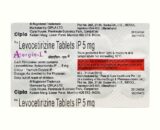

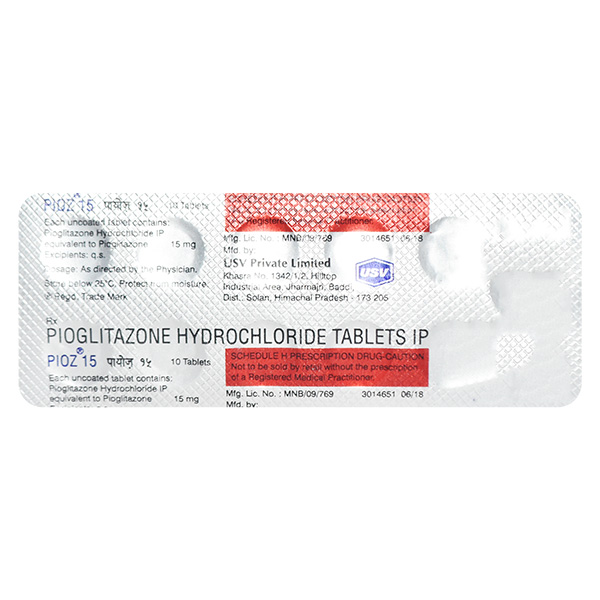
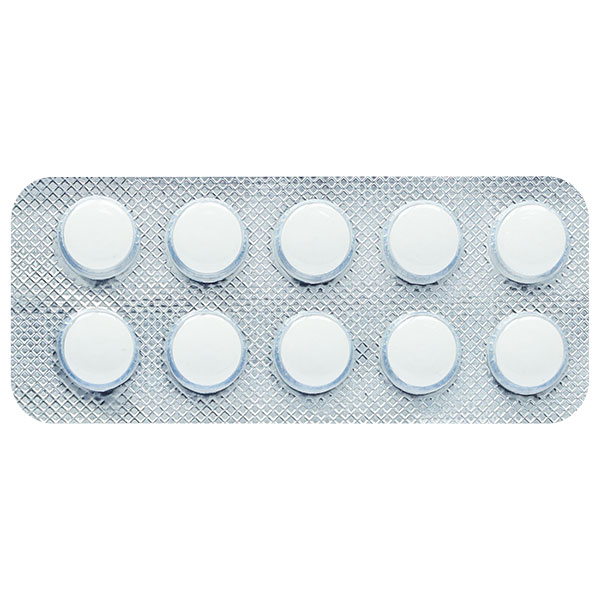



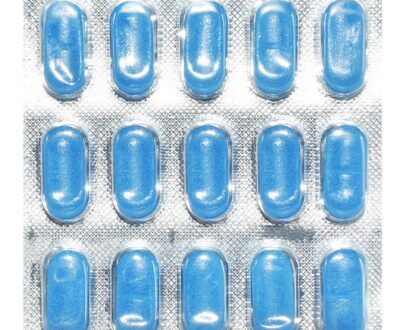
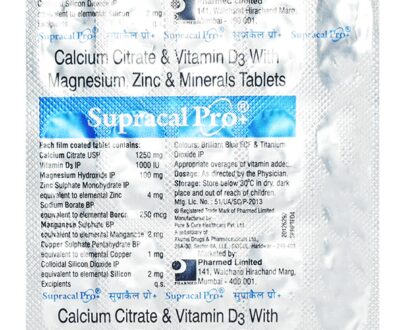

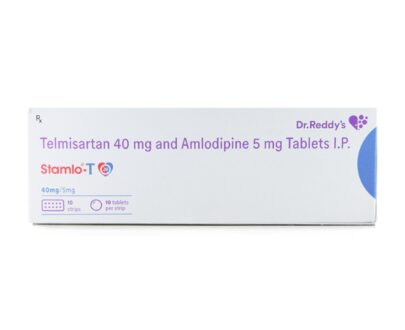

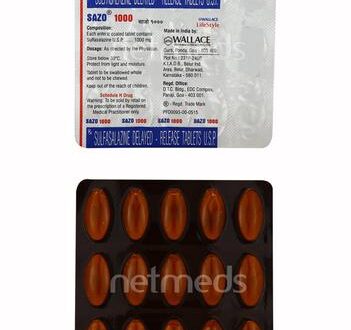
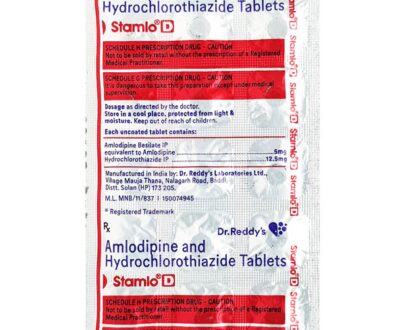
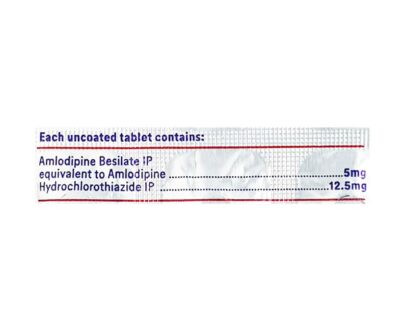
Customer reviews
Reviews
There are no reviews yet.
Only logged in customers who have purchased this product may leave a review.